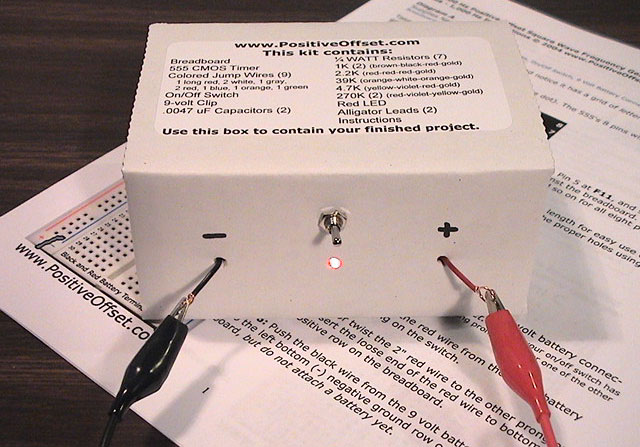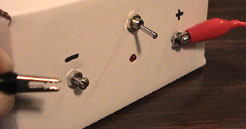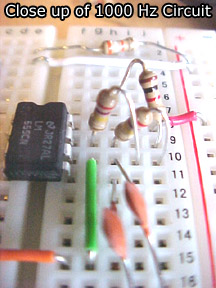Frequently Asked Questions on How to Build a Hulda Clark Zapper
Zapper History
This is a brief introduction to the scientists who experimented with frequency healing over the past 120 years. Nikola Tesla, George Lakhovsky, Royal Raymond Rife, Bob Beck, Hulda Clark, and many more all contributed to the history of exploring electro-medicine, and the history of zapping. Research these scientists, read their books, and be amazed!
Your zapper parts are different from Hulda Clark's original parts list. For example, one of your resistors is 39K Ohm and Hulda Clark's is 3.9K Ohm. Why?
In the books published in 2003 and beyond, Hulda Clark updated her zapper schematic for two reasons:
First the addition of the 39K Ohm resistor forces the square wave an extra 1/4 volt above zero so the device is more Positive Offset to keep the wave form far away from any negative output or negative spikes. That is why many zapper vendors claim to use Dr. Clark's "updated" zapper design.
The second reason for the change is that Dr. Clark also published a second low frequency zapper design that has an output of 1 kHz and runs through a North Pole Speaker. The circuit design allows one to simply change the resistors on the 555 CMOS Timer at pin 6/7 to switch from 30 kHz to 1 kHz output. Your parts list is from one of Dr. Clark's first books before she discovered and published the uses for 1 kHz. Her book, Prevention Of All Cancers has so many new experiments and advanced zapper information. I recommend it to anyone interested in taking zapping further than the original 30 kHz device.
I do not know how to solder electronics. Do I have to solder this kit?
No soldering required to build the breadboard circuit. When Dr. Clark updated her zapper, she published an easy to build breadboard circuit because there is no soldering required. You just push the resistors and capacitors into place on the breadboard.
What kind of tools will I need to build the zapper kit?
Tools and Supplies Needed for Building a Hulda Clark Breadboard Zapper Kit:
- Wire Stripper-Snippers
- Needle-Nose Pliers (some have stripper snippers)
- 9 Volt Battery (battery is not included in kit)
- Two 4" pieces of 3/4" copper pipe (not included in kit. Copper pipes are available here)
Which way do the resistors and capacitors go in?
Only the 555 CMOS Timer and the Red LED have polarity and go into the breadboard a specific way. As long as the resistors and capacitors are in their correct spots on the breadboard, the circuit will work.
What should I contain my finished circuit in?
The Zapper Kit comes in a small cardboard box that is perfect for holding the finished zapper circuit. Be sure the container you decide to use is made of a nonconductive material. Do not use containers that are metal or metallic. Containers made of plastic, cardboard, or wood are good choices.
Simple Solution: Output Wires and a Cardboard Box
Below we simply poked two holes for two output wires that connect inside to the circuit's ground and positive output. We marked the ground wire (-) and the positive output with a (+). The looped end of the two output wires make connecting mini alligator clip leads and copper pipes easy (copper pipes sold separately).


Here is the inside view. A few tips: notice that all holes in the box are in the back. This is so when you close the box's lid, the part of the lid that tucks in will not interfere with the wires and switch. Holes in box were made using a small nail. The two output wires are knotted behind the holes, so if they are pulled, they do not pull out of the breadboard. LED was bent down carefully and pushed through hole, same with switch above it.
Once you get this far, check the circuit and switch connections. Make sure everything is OK. Turn switch on, and LED should light up. If not, disconnect battery and check connections again. Our zapper kit uses a special breadboard that has foam tape on the back so that you can stick the breadboard onto any smooth dry surface. Get creative, and have fun deciding how to contain your finished breadboard circuit. As with all handmade electronic devices, remember to remove battery when not in use.
Optional Modification: Bolt Terminals


Another optional modification is to add Bolt Terminals to your zapper. You will need two bolts and four nuts (nuts and bolts sold separately). Screw one nut midway on each bolt, insert bolts into the (-) (+) holes on the front of the box. Connect the ground and positive output wires from the circuit to the two bolts on the inside of the box. Make sure that enough plastic insulation has been removed from each output wire so that the bare wire loops around the bolt. Tighten the nut to capture the loop of bare wire. Now it is easy to grip the bolt on the outside with alligator clip leads. This is a simple way to secure the output wires. Tighten bolt so that it hangs out in front to make gripping with the alligator leads easy. Be sure that the bolts do not come in contact with the other electronic parts inside the box.
How do I test my zapper after I have built the kit?
 Chapter 9 of the Video shows how
to test the Hz output on a Multimeter. This circuit should measure a
frequency between 20-40 kHz. The peak to peak voltage is about 8 volts.
A voltage meter will show 4-5 volts (the 50% duty cycle will give you
the average of 8 & 0 = 4).
Chapter 9 of the Video shows how
to test the Hz output on a Multimeter. This circuit should measure a
frequency between 20-40 kHz. The peak to peak voltage is about 8 volts.
A voltage meter will show 4-5 volts (the 50% duty cycle will give you
the average of 8 & 0 = 4).
To check the positive offset square wave on an oscilloscope you could visit a local VCR/TV repair shop. Start out by setting the oscilloscope to the .5 volt division scale. Be sure that the square wave is about 1/4 volt positive offset. There should be NO negative spikes. The duty cycle, voltage, and frequency of the zapper are less important than an absence of negative spikes. For more technical information on the ways Dr. Clark tests and experiments with a zapper, please read the Syncrometer Lab Manual and the Prevention book by Dr. Hulda Clark.
 Make The
1000 Hz Zappicator with One Simple Change!
Make The
1000 Hz Zappicator with One Simple Change!
When Hulda Clark published the update to her 30 kHz zapper circuit, she also published a low frequency breadboard circuit for a new experimental device known as the 1000 Hz (1 kHz) Zappicator.
The unit is used along with a North Pole Speaker as part of a Zappicator. The breadboard circuit was cleverly designed so that it was easy to build the 30 kHz or the 1000 Hz device with one simple change.
If you want to build a 1000 Hz unit instead of the 30 kHz zapper, this is all you have to do: In the Build A Zapper Video, the last resistor to be put in place is the 4.7K (yellow-violet-red-gold). Pull out the 4.7K resistor and replace it with two 270K resistors (red-violet-yellow-gold). It's a tight squeeze, so bend each resistor into a hairpin shape as described in the video, and cut the wires even.
Place the first 270K on the breadboard at G9-I10. The second 270K goes from H9-J10. When this circuit is tested on a Multimeter it should read about 1000 Hz (also read as 1 kHz).
Food Zappicator
When one is setting up a Hulda Clark Food Zappicator be sure to connect the 1000Hz circuit's positive (+) output to the North Pole Speaker's (+) terminal. The ground (-) is not used when setting up a Hulda Clark Food Zappicator.
The speaker can be 4 or 8 ohm two inch speaker. In order for the speaker to be considered a North Pole Speaker, the N on a compass must be attracted to the speaker's top paper face. Contain speaker in a nonmetal box. Wood or plastic is best. Hot glue speaker inside box. Place food/water on top in nonmetal containers. Remove all metal caps. Zap 10-20 minutes. Read the latest books by Hulda Clark for complete details on using a Food Zappicator.
Order a Zapper Kit and Copper Pipes below:
Already have electronic parts?
Get a Hulda Clark Zapper handbuilt for you:
The Hulda Clark Zapper has not been licensed as a medical device by the US FDA. The Build Your Own Zapper Kit is sold as an educational tool only. No medical claims are intended by the sale of these electronic parts. Our Zapper Kit is a great project for a school science fair or to learn the basics of building simple electronics. Please note that when ordering electronic parts and kits we can assume no liability on the customer's ability to use them. Safety, craftsmanship, experience, and ability are the user's responsibility. Electronic parts are small and fragile. We can not offer refunds or replacements on electronic parts. Buy electronic parts and kits only if you believe you can accomplish the work.
The 555 CMOS Timer is the most likely part to need replacement, so it may be smart to order extras when building a kit.
The 555 CMOS Timer is vulnerable to static electricity. If you walk on a carpeted floor and the 555 receives a static shock it may burn out and need replacement. If you ever touch the 9-volt battery backwards to the battery snap, it may burn out the 555. You may want to protect your 555 by adding a 1N914 Switching Diode to your kit.

